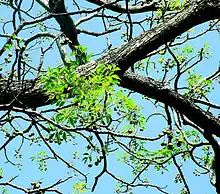| Melia dubia | |
|---|---|
 | |
| Leaves and fruits | |
| Scientific classification | |
| Kingdom: | Plantae |
| Clade: | Tracheophytes |
| Clade: | Angiosperms |
| Clade: | Eudicots |
| Clade: | Rosids |
| Order: | Sapindales |
| Family: | Meliaceae |
| Genus: | Melia |
| Species: | M. dubia |
| Binomial name | |
| Melia dubia | |
| Synonyms | |
|
Melia composita Willd. | |
Melia dubia Commonly known as Malabar Neem, Maha Neem, Gora Neem, or Barma Dhek. This is one of the most important industrial tree species that has rapidly expanded in the Indian subcontinents in recent decades. M. dubia is a tree of tropical and subtropical regions which is mainly cultivated for its widely important industrial and medicinal qualities. It belongs to the family Meliaceae. It is distributed all throughout India (with the exception of Jammu & Kashmir, Himachal Pradesh, and Sikkim). The species is native to Southern Asia, and has been introduced in South Africa, the Middle East, North and South America, Bermuda, Brazil, Argentina, Southeast Australia, Asia Pacific, and southern Europe. It grows up to 6m to 30m in height, with a spreading crown and straight bole of 10m, and a tap root. It grows in a variety of soil types, such as deep fertile sandy loam and shallow gravelly soil. Melia dubia is drought tolerant in nature. It grows annually in a temperature of 23-43 °C and altitude up to 1800m, and grows well in annual rainfall ranging from 750- 1500mm, requiring a soil pH range from 5.5 to 7. Flowers are bisexual, borne on terminal panicles in upper axil and shorter leaves. Flowering occurs January to March, fruiting occurs November to February, [1][2] and leaf fall occurs from February to March. Melia dubia is said to possess medical properties and is used in the treatment of various ailments such as cancer. It may also be used as an anti-diabetic, anti-tumour, anti-inflammatory, antioxidant, antibacterial, antiviral, and fungicidal treatment.
References
- ↑ "Melia dubia". India Biodiversity. India Biodiversity. Retrieved 28 November 2019.
- ↑ Ganesan, Dr. R; Kavitha, A; Gladwin, J; Deepthi, N (2012). Common dryland trees of Karnataka: Bilingual field guide. Karnataka, India.: Ashoka Trust for Research in Ecology and the Environment.